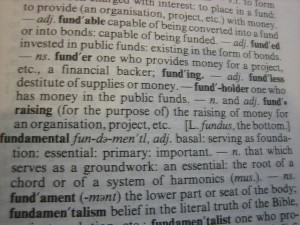
This promo piece led me to think about what’s missing from the series: relationships.
Here, for free–and no travel expenses–are 6 tips you can call “Mastering the Relationship.”
- Be a good listener.
You can learn so much from active listening to–and engagement with–your prospects and donors. Much more than the best prospect researcher can find for you. I’ve written about meetings versus research. Focus conversations on why people love your work, then listen carefully. You’ll hear all kinds of clues about what they want to give to; what moves them; what they don’t like; how your work has been important to them and their families. That’s all valuable in strengthening your relationships–and your solicitations. (Follow my advice or pay $500 for Mastering the Ask.) - Remember anniversaries.
Not merely weddings and birthdays. If you want to stand out, remember donors’ gift-making anniversaries. In Planned Giving, remember the anniversary of when bequest donors informed you they put you in their will. Apply this to all types of fundraising. You’re commemorating anniversaries your donors don’t even recognize. Their gift was that important to you. Will you impress your donors! (You have the data you need in your fundraising management software.) - Write handwritten notes.
Why? Because hardly anyone does. I can’t say, “no one does” because our clients do. But you’ll be among the very few. Now that you’re remembering anniversaries, do it this way. Planned gift donors especially appreciate handwritten notes. Most of them grew up writing on stationery. But they’re not the only ones. Plus, you save time writing a sincere, heartfelt note rather than struggling to fill an eight-and-a-half-by-eleven sheet in Word. I avoid Word for personal, heart-whole correspondence. - Get out of the office.
If your job is fundraising, you have to get out of your office and see people. Seventy-five percent of your time should be outside. Delegate. Stop volunteering for committees. Plead with your boss to offload administrative tasks. Spend time with your prospects and donors where they live, work or play. - Make introductions.
Do your prospects know donors? Do your donors know other donors? They should. The more relationships you can build through your nonprofit, the more valuable it becomes to those you’re cultivating. So many fundraisers are buzzing about relationship-building using social media properties. Let’s not forget the strength of an introduction, a handshake and a new friend. Don’t ignore the value of, “There’s someone I’d like you to meet.” You are the connector. Your nonprofit is the connection. - Be good to people.
I hope you genuinely enjoy the company of people, because you’re in a people business. It’s not tax codes and net income charitable remainder unitrusts with make-up provision. You’ve got to like people. That will make it so much easier to treat them with respect, sensitivity, good humor, honesty and compassion. To treat them the way you’d like to be treated.
People give to charitable missions they love that are represented by people they like.
You’ll be more liked if you take these tips to heart.
These are great tips! If you’re a development professional, follow them…especially the “get out of the office” one. It’s too bad that there are Supervisors out there that still want their employees to “come to the office on time and not leave early.” Secretaries and Administrative Assistants, sure! Development professionals, hell no. Breakfast meetings, dinner meetings, and Saturday and Sunday meetings to make those connections are necessary. If you’re a development professional and your supervisor is a micromanager that won’t let you do what’s necessary to succeed, you need to find a new supervisor (read: new job).
It should be noted and understood that, before any of the six steps mentioned can be taken, it is essential to thoroughly know the history, mission, and success of your organization. Some of you may be saying “Duh!” but you would be amazed at how many NPOs I have worked with fail to lay the proper groundwork for the ask. Unfortunately, too many NPOs subscribe to the “begging-to-keep-the-doors-open” approach rather than making the prospective donor an integral part of a successful future vision. The nonprofit world, in general, has a long way to go in developing a business approach to asking for gifts.
You perfectly distilled the key points for building and sustaining donor relationships. A great post!
These 6 tips are the foundation of all effective cultivation and solicitation. Tony, you have done it again!
Excellent advice you can hold in your hand, especially the hand that is asking!
Blessings
Tony: Great micro course. I am forwarding it to my major donor soliticitation volunteer.
I adhered to every one of these “tips” when I worked with a regional CBO and as a result, I built wonderful, lasting relationships with my donors.
This short piece boils down to the essentials so much of what we (should) do to build relationships that lead donors and prospects to support of our missions/ministries. Well done and well said!
#7 (should be #1). Never, never, never shade the truth.